[English] 日本語
 Yorodumi
Yorodumi- PDB-6jt1: Structure of human soluble guanylate cyclase in the heme oxidised... -
+ Open data
Open data
- Basic information
Basic information
| Entry | Database: PDB / ID: 6jt1 | |||||||||||||||
|---|---|---|---|---|---|---|---|---|---|---|---|---|---|---|---|---|
| Title | Structure of human soluble guanylate cyclase in the heme oxidised state | |||||||||||||||
 Components Components |
| |||||||||||||||
 Keywords Keywords | SIGNALING PROTEIN / soluble guanylate cyclase | |||||||||||||||
| Function / homology |  Function and homology information Function and homology informationretrograde trans-synaptic signaling by nitric oxide, modulating synaptic transmission / cytidylate cyclase activity / trans-synaptic signaling by nitric oxide, modulating synaptic transmission / guanylate cyclase complex, soluble / guanylate cyclase / cGMP biosynthetic process / guanylate cyclase activity / presynaptic active zone cytoplasmic component / response to oxygen levels / Nitric oxide stimulates guanylate cyclase ...retrograde trans-synaptic signaling by nitric oxide, modulating synaptic transmission / cytidylate cyclase activity / trans-synaptic signaling by nitric oxide, modulating synaptic transmission / guanylate cyclase complex, soluble / guanylate cyclase / cGMP biosynthetic process / guanylate cyclase activity / presynaptic active zone cytoplasmic component / response to oxygen levels / Nitric oxide stimulates guanylate cyclase / relaxation of vascular associated smooth muscle / adenylate cyclase activity / blood circulation / cGMP-mediated signaling / positive regulation of nitric oxide mediated signal transduction / Smooth Muscle Contraction / cellular response to nitric oxide / nitric oxide mediated signal transduction / GABA-ergic synapse / nitric oxide-cGMP-mediated signaling / Hsp90 protein binding / regulation of blood pressure / signaling receptor activity / glutamatergic synapse / heme binding / protein-containing complex binding / GTP binding / metal ion binding / cytosol Similarity search - Function | |||||||||||||||
| Biological species |  Homo sapiens (human) Homo sapiens (human) | |||||||||||||||
| Method | ELECTRON MICROSCOPY / single particle reconstruction / cryo EM / Resolution: 3.9 Å | |||||||||||||||
 Authors Authors | Chen, L. / Kang, Y. / Liu, R. / Wu, J.-X. | |||||||||||||||
| Funding support |  China, 4items China, 4items
| |||||||||||||||
 Citation Citation |  Journal: Nature / Year: 2019 Journal: Nature / Year: 2019Title: Structural insights into the mechanism of human soluble guanylate cyclase. Authors: Yunlu Kang / Rui Liu / Jing-Xiang Wu / Lei Chen /  Abstract: Soluble guanylate cyclase (sGC) is the primary sensor of nitric oxide. It has a central role in nitric oxide signalling and has been implicated in many essential physiological processes and disease ...Soluble guanylate cyclase (sGC) is the primary sensor of nitric oxide. It has a central role in nitric oxide signalling and has been implicated in many essential physiological processes and disease conditions. The binding of nitric oxide boosts the enzymatic activity of sGC. However, the mechanism by which nitric oxide activates the enzyme is unclear. Here we report the cryo-electron microscopy structures of the human sGCα1β1 heterodimer in different functional states. These structures revealed that the transducer module bridges the nitric oxide sensor module and the catalytic module. Binding of nitric oxide to the β1 haem-nitric oxide and oxygen binding (H-NOX) domain triggers the structural rearrangement of the sensor module and a conformational switch of the transducer module from bending to straightening. The resulting movement of the N termini of the catalytic domains drives structural changes within the catalytic module, which in turn boost the enzymatic activity of sGC. | |||||||||||||||
| History |
|
- Structure visualization
Structure visualization
| Movie |
 Movie viewer Movie viewer |
|---|---|
| Structure viewer | Molecule:  Molmil Molmil Jmol/JSmol Jmol/JSmol |
- Downloads & links
Downloads & links
- Download
Download
| PDBx/mmCIF format |  6jt1.cif.gz 6jt1.cif.gz | 231 KB | Display |  PDBx/mmCIF format PDBx/mmCIF format |
|---|---|---|---|---|
| PDB format |  pdb6jt1.ent.gz pdb6jt1.ent.gz | 177.9 KB | Display |  PDB format PDB format |
| PDBx/mmJSON format |  6jt1.json.gz 6jt1.json.gz | Tree view |  PDBx/mmJSON format PDBx/mmJSON format | |
| Others |  Other downloads Other downloads |
-Validation report
| Summary document |  6jt1_validation.pdf.gz 6jt1_validation.pdf.gz | 798.5 KB | Display |  wwPDB validaton report wwPDB validaton report |
|---|---|---|---|---|
| Full document |  6jt1_full_validation.pdf.gz 6jt1_full_validation.pdf.gz | 815.4 KB | Display | |
| Data in XML |  6jt1_validation.xml.gz 6jt1_validation.xml.gz | 35.3 KB | Display | |
| Data in CIF |  6jt1_validation.cif.gz 6jt1_validation.cif.gz | 53.6 KB | Display | |
| Arichive directory |  https://data.pdbj.org/pub/pdb/validation_reports/jt/6jt1 https://data.pdbj.org/pub/pdb/validation_reports/jt/6jt1 ftp://data.pdbj.org/pub/pdb/validation_reports/jt/6jt1 ftp://data.pdbj.org/pub/pdb/validation_reports/jt/6jt1 | HTTPS FTP |
-Related structure data
| Related structure data |  9884MC  9883C  9885C  9886C  6jt0C  6jt2C M: map data used to model this data C: citing same article ( |
|---|---|
| Similar structure data |
- Links
Links
- Assembly
Assembly
| Deposited unit | 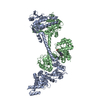
|
|---|---|
| 1 |
|
- Components
Components
| #1: Protein | Mass: 77566.484 Da / Num. of mol.: 1 Source method: isolated from a genetically manipulated source Details: GenBank: AAH28384.1 / Source: (gene. exp.)  Homo sapiens (human) / Gene: GUCY1A1, GUC1A3, GUCSA3, GUCY1A3 / Production host: Homo sapiens (human) / Gene: GUCY1A1, GUC1A3, GUCSA3, GUCY1A3 / Production host:  |
|---|---|
| #2: Protein | Mass: 70599.320 Da / Num. of mol.: 1 Source method: isolated from a genetically manipulated source Source: (gene. exp.)  Homo sapiens (human) / Gene: GUCY1B1, GUC1B3, GUCSB3, GUCY1B3 / Production host: Homo sapiens (human) / Gene: GUCY1B1, GUC1B3, GUCSB3, GUCY1B3 / Production host:  |
| #3: Chemical | ChemComp-HEM / |
| Has ligand of interest | N |
-Experimental details
-Experiment
| Experiment | Method: ELECTRON MICROSCOPY |
|---|---|
| EM experiment | Aggregation state: PARTICLE / 3D reconstruction method: single particle reconstruction |
- Sample preparation
Sample preparation
| Component | Name: human soluble guanylate cyclase / Type: COMPLEX / Entity ID: #1-#2 / Source: RECOMBINANT |
|---|---|
| Source (natural) | Organism:  Homo sapiens (human) Homo sapiens (human) |
| Source (recombinant) | Organism:  |
| Buffer solution | pH: 7.5 |
| Specimen | Embedding applied: NO / Shadowing applied: NO / Staining applied: NO / Vitrification applied: YES |
| Vitrification | Cryogen name: ETHANE |
- Electron microscopy imaging
Electron microscopy imaging
| Experimental equipment |  Model: Titan Krios / Image courtesy: FEI Company |
|---|---|
| Microscopy | Model: FEI TITAN KRIOS |
| Electron gun | Electron source:  FIELD EMISSION GUN / Accelerating voltage: 300 kV / Illumination mode: FLOOD BEAM FIELD EMISSION GUN / Accelerating voltage: 300 kV / Illumination mode: FLOOD BEAM |
| Electron lens | Mode: BRIGHT FIELD |
| Image recording | Electron dose: 50 e/Å2 / Film or detector model: GATAN K2 QUANTUM (4k x 4k) |
- Processing
Processing
| EM software | Name: RELION / Version: 3 / Category: 3D reconstruction |
|---|---|
| CTF correction | Type: NONE |
| 3D reconstruction | Resolution: 3.9 Å / Resolution method: FSC 0.143 CUT-OFF / Num. of particles: 379909 / Symmetry type: POINT |
 Movie
Movie Controller
Controller


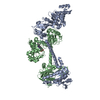
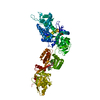
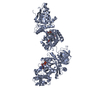

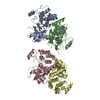
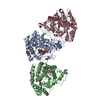
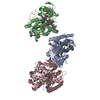

 PDBj
PDBj








